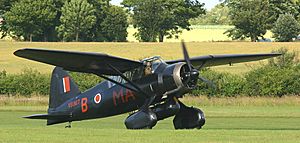Violette Szabo facts for kids
Quick facts for kids
Violette Szabo
|
|
|---|---|
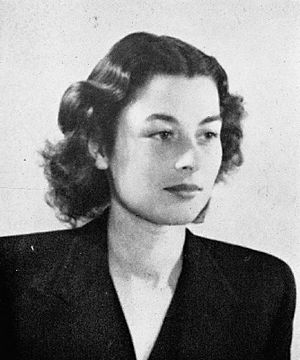
Violette Szabo c.1944
|
|
| Born | 26 June 1921 Paris, France |
| Died | 5 February 1945 (aged 23) KZ Ravensbrück, Germany |
| Allegiance | United Kingdom |
| Service/ |
Auxiliary Territorial Service First Aid Nursing Yeomanry |
| Years of service | 1941–1945 |
| Rank | Ensign |
| Unit | Special Operations Executive F Section |
| Battles/wars | Second World War |
| Awards | George Cross Croix de Guerre (France) Resistance Medal (France) |
Violette Szabo (born Violette Bushell on 26 June 1921 – died around 5 February 1945) was a brave British-French secret agent. She worked for the Special Operations Executive (SOE) during World War II. After the war, she was given the George Cross, a very high award for bravery.
On her second mission in France, Violette was captured by the German army. She was questioned and sent to Ravensbrück concentration camp in Germany. There, she was sadly executed.
Contents
Early Life of Violette Szabo
Violette Bushell was born in Paris, France, on 26 June 1921. She was the second of five children and the only girl. Her father, Charles George Bushell, was a British soldier. He met her mother, Reine Blanche Leroy, a dressmaker, during World War I.
After the war, her parents lived in London. Charles worked as a taxi driver and car salesman. In the early 1930s, Violette and her youngest brother lived with their aunt in France. The family reunited in South London when Violette was 11.
Violette was a very active and lively girl. She loved gymnastics, long bike rides, and ice-skating. She was known as a tomboy. Her father taught her to shoot, and she was very accurate.
She quickly relearned English after returning from France. Violette was popular at school in Brixton. Her family often spoke French at home.
At 14, Violette started working for a French corset maker. Later, she worked at Woolworths. When World War II began, she was working at a department store in Brixton.
Joining the War Effort
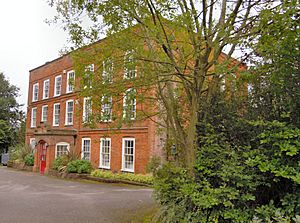
In early 1940, Violette joined the Women's Land Army. She picked strawberries in Fareham, Hampshire. But she soon returned to London to work in a factory making weapons.
She met Étienne Szabo, a French soldier, in London in 1940. They met at a Bastille Day parade. Violette's mother had sent her to invite a homesick French soldier for dinner. Violette and Étienne fell in love quickly. They married on 21 August 1940. Violette was 19, and Étienne was 31.
Étienne soon left to fight in the war. He fought in Africa and Syria. He returned to the UK for a short visit later that year.
After marrying, Violette worked as a switchboard operator. She worked in central London during the London Blitz, when German planes bombed the city. She found the job boring. So, she joined the Auxiliary Territorial Service (ATS) on 11 September 1941.
She trained in Leicester and Oswestry. She became a gunner in an anti-aircraft battery. After more training, she was posted to Frodsham. Within weeks, Violette found out she was pregnant. She left the ATS and went back to London.
Family and Loss
Violette moved into a flat in Notting Hill. This was her home until her second mission to France. On 8 June 1942, her daughter Tania Damaris Desiree Szabo was born. At the same time, Étienne was fighting in North Africa.
Violette sent her baby to childminders. She worked at an aircraft factory. During this time, she received terrible news. Her husband, Étienne, had died in battle. He died on 24 October 1942. He was leading his men in an attack in North Africa. He never got to see his daughter.
Étienne's death made Violette want to fight the enemy even more. She decided to train as a secret agent. She joined the British Special Operations Executive (SOE).
Becoming a Secret Agent
It's not fully clear how Violette was chosen for the SOE. But she spoke French very well. She had also served in the ATS. These skills likely caught the SOE's attention. She was given security clearance on 1 July 1943. She was chosen for agent training on 10 July.
Violette trained as a section leader in the First Aid Nursing Yeomanry (FANY). This was a civilian service often used as a cover for female SOE agents.
She went through intense training. This included fieldcraft, navigation, weapons, and demolition. Her trainers had mixed opinions of her. But she passed the courses. She moved on to the "finishing school" at Beaulieu. Here, she learned how to escape and avoid capture. She also learned about communications and codes.
The final part of her training was parachute jumping. On her first try, she badly sprained her ankle. This ankle would cause her trouble later in France. She recovered and passed the parachuting course in February 1944.
In 2012, writer Max Hastings said Violette was "adored" by other SOE members. They loved her courage and her "infectious Cockney laughter."
First Mission in France
Violette's first mission was delayed because of her ankle injury. She met Philippe Liewer during her training. SOE decided she would work as a courier for Liewer's "Salesman" network.
On 5 April 1944, Violette and Liewer flew from RAF Tempsford. They parachuted into German-occupied France near Cherbourg-Octeville. Her cover story was that she was a secretary named Corinne Reine Leroy. She used her mother's names and her real birthdate.
Her code name was "Louise," which was also her nickname. She was also called "La P'tite Anglaise" (The Little Englishwoman) because she was only 5'3" tall. She and Liewer tried to find out how much damage the Germans had done to their network. Violette traveled to Rouen and Dieppe. She gathered information and checked things out.
It became clear that the network was badly damaged. Violette returned to Paris to tell Liewer. She also bought gifts for her daughter and mother. Her reports on factories making war materials were very important. They helped the Allies choose bombing targets.
She returned to England on 30 April 1944. She flew in a Westland Lysander plane. The flight was stressful. The plane was hit by anti-aircraft fire. Violette was thrown around the plane. When they landed, she thought they had been shot down. She yelled at the pilot in French, thinking he was German. When she realized what happened, she gave him a kiss. On 24 May 1944, Violette was promoted to Ensign in the FANY.
Second Mission in France
Violette's second mission began on 8 June 1944. This was just after D-Day. She and three colleagues parachuted into France near Limoges. Violette was part of a four-person team. The team was called 'Salesman II'. It was led by Philippe Liewer.
Violette's job was to help the local French Resistance fighters. They were called the maquis. She helped them cut communication lines. This was to stop German troops from reaching the Normandy landings.
When Liewer arrived, he found the local maquis were not ready. He sent Violette to connect with stronger maquis groups. But he didn't know that a German Panzer Division was moving through the area.
Capture and Interrogation
On 10 June, Violette set off on her mission. She was in a car driven by a young maquis leader, Jacques Dufour. They picked up another Resistance friend, Jean Bariaud. Violette was armed with a Sten gun and ammunition.
Their car was stopped by German troops. The Germans were looking for a missing officer. Bariaud managed to escape and warn the Salesman team.
Violette and Dufour jumped from the car. A gun battle started. Violette fell and badly twisted her ankle. She told Dufour to escape. She dragged herself to an apple tree. From behind the tree, she fired at the Germans. She fought them for thirty minutes. She killed at least one German soldier and wounded others.
Eventually, she ran out of ammunition. She was captured by two men. They took her to a bridge. She was hot, messy, and in pain. She was questioned by a young officer.
Violette was taken to the Sicherheitsdienst (SD) in Limoges. She was questioned for four days. She gave a fake name, "Vicky Taylor." From there, she was moved to Fresnes Prison in Paris. She was then taken to Gestapo headquarters. The Gestapo knew her real identity as an SOE agent.
Life in Ravensbrück
As the Allies moved deeper into France, the Germans sent important prisoners to Germany. On 8 August 1944, Violette was put on a train. She was shackled to another SOE agent, Denise Bloch. Other prisoners were also on the train.
During the journey, an Allied air raid happened. The guards left the train. Violette and Denise got water for the male prisoners. They helped keep everyone's spirits up.
From Reims, the prisoners went to a transit camp. Conditions were terrible. There was no hygiene, and food was bad. After about ten days, Violette and most women were sent to Ravensbrück concentration camp. Over 92,000 women died there during the war. The journey was eighteen days long.
Even in Ravensbrück, Violette kept her spirits up. She helped save another prisoner's life. She always planned to escape. While there, Violette, Denise Bloch, and Lilian Rolfe were sent to a factory. They refused to make weapons. They were forced to work outside, digging potatoes.
Later, Violette and the others were sent to a punishment camp. They had to do hard physical labor. They cut down trees and dug trenches. Violette volunteered for tree-felling. This gave some shelter from the cold winds. The winter was very harsh. Women had to stand for roll-call for hours in the freezing cold. Many froze to death. Violette only had summer clothes. They had little food and no blankets.
Violette tried to stay positive. She kept planning to escape. In January 1945, the three British agents were sent back to Ravensbrück. They were put in solitary confinement. They were already weak. This abuse finally broke Violette's spirit.
Execution
Violette Szabo was killed at Ravensbrück. She was 23 years old. This happened on or before 5 February 1945. She was executed by an SS officer. Other camp leaders were present. Denise Bloch and Lilian Rolfe were also executed at the same time. Their bodies were burned in the camp crematorium.
Forty-one female SOE agents served in France. Twenty-six of them survived the war. Twelve were executed, including Violette.
Awards and Honors
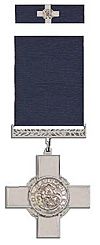
Violette Szabo was the second woman to receive the George Cross. This award was given to her after her death on 17 December 1946.
The French government also gave her the croix de guerre in 1947. She also received the Médaille de la Résistance in 1973. Violette Szabo is listed on the Valençay SOE Memorial. This memorial honors agents who died for France's freedom.
Both Violette and Étienne Szabo received the French Croix de Guerre. On 28 January 1947, their four-year-old daughter Tania received Violette's George Cross. King George VI presented it to her. Violette and Étienne Szabo are thought to be the most decorated married couple of World War II.
In 2015, Violette Szabo's medals were sold at auction. They were bought by Lord Ashcroft. He put the George Cross on display at the Imperial War Museum.
Museums and Memorials
Violette Szabo has no known grave. She is remembered at the Commonwealth War Graves Commission Brookwood Memorial in Surrey.
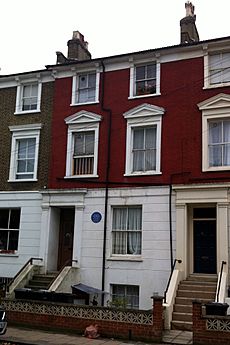
The Violette Szabo GC Museum is in a cottage in Wormelow Tump, Herefordshire. Violette used to visit her cousins there. She also stayed at the farm while recovering from her ankle injury. Tania Szabo attended the museum's opening in 2000.
The Jersey War Tunnels have a special room for Violette Szabo. The Royal College of Music gives an award in her name.
There is a mural dedicated to Violette Szabo in Stockwell, South London. It was painted in 2001. It shows famous people from Stockwell, including Violette.
In 2008, a bronze statue of Violette Szabo was unveiled. It is on the Albert Embankment in London.
There is a plaque at Lambeth Town Hall remembering her.
There are also memorials to Violette in France. One is near where her team landed in 1944. Another is at the Valençay SOE Memorial. She is also remembered at RAF Tempsford.
A memorial to Violette Szabo is at the rugby field in Salon-la-Tour. This is where she was captured.
Violette Szabo in Media
Violette Szabo's daughter, Tania Szabo, wrote a book about her mother's missions. The book is called Young Brave and Beautiful.
Violette's wartime story was made into a film. It is called Carve Her Name with Pride. The film is based on a book by R. J. Minney.
The 2009 video game Velvet Assassin is inspired by Violette's life. The main character in the game shares her first name.
A short play called "The Life That I Have" was created in 2018. It is about Violette's last moments in Ravensbrück.
In 2018, Tania Szabo was interviewed about her mother. This was for the BBC show Antiques Roadshow.
See also
 In Spanish: Violette Szabo para niños
In Spanish: Violette Szabo para niños


